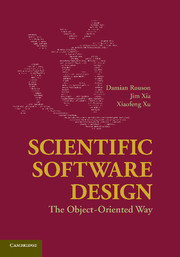Preface
Published online by Cambridge University Press: 01 June 2011
Summary
This book is about software design. We use “design” here in the sense that it applies to machines, electrical circuits, chemical plants, and buildings. At least two differences between designing scientific software and designing these other systems seem apparent:
The extent to which one communicates a system's structure by representing schematically its component parts and their interrelationships,
The extent to which such schematics can be analyzed to evaluate suitability and prevent failures.
Schematic representations greatly simplify communications between developers. Analyses of these schematics can potentially settle long-standing debates about which systems will wear well over time as user requirements evolve and usage varies.
This book does not chiefly concern high-performance computing. While most current discussions of scientific programming focus on scalable performance, we unabashedly set out along the nearly orthogonal axis of scalable design. We analyze how the structure of a package determines its developmental complexity according to such measures as bug search times and documentation information content. We also present arguments for why these issues impact solution cost and time more than does scalable performance.
We firmly believe that science is not a horse race. The greatest scientific impact does not necessarily go to the swiftest code. Groundbreaking results often occur at the intersection of multiple disciplines, where the basic science is so poorly understood that important insights can be gleaned from creative simulations of modest size.
- Type
- Chapter
- Information
- Scientific Software DesignThe Object-Oriented Way, pp. xvii - xxPublisher: Cambridge University PressPrint publication year: 2011



